NISSAN LEAF 2023 Owners Manual
Manufacturer: NISSAN, Model Year: 2023, Model line: LEAF, Model: NISSAN LEAF 2023Pages: 612, PDF Size: 7.42 MB
Page 581 of 612
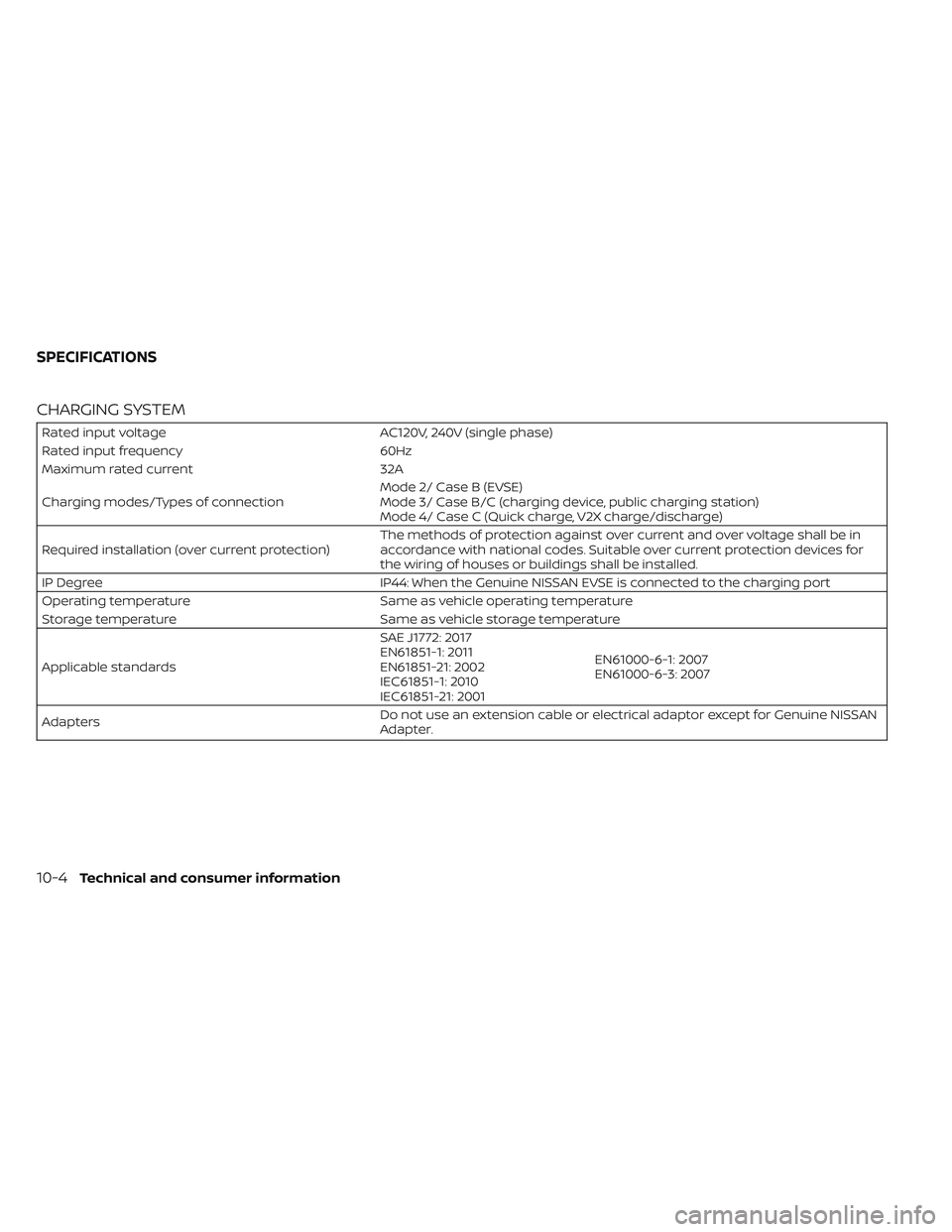
CHARGING SYSTEM
Rated input voltageAC120V, 240V (single phase)
Rated input frequency 60Hz
Maximum rated current 32A
Charging modes/Types of connection Mode 2/ Case B (EVSE)
Mode 3/ Case B/C (charging device, public charging station)
Mode 4/ Case C (Quick charge, V2X charge/discharge)
Required installation (over current protection) The methods of protection against over current and over voltage shall be in
accordance with national codes. Suitable over current protection devices for
the wiring of houses or buildings shall be installed.
IP Degree IP44: When the Genuine NISSAN EVSE is connected to the charging port
Operating temperature Same as vehicle operating temperature
Storage temperature Same as vehicle storage temperature
Applicable standards SAE J1772: 2017
EN61851-1: 2011
EN61851-21: 2002
IEC61851-1: 2010
IEC61851-21: 2001EN61000-6-1: 2007
EN61000-6-3: 2007
Adapters Do not use an extension cable or electrical adaptor except for Genuine NISSAN
Adapter.
SPECIFICATIONS
10-4Technical and consumer information
Page 582 of 612
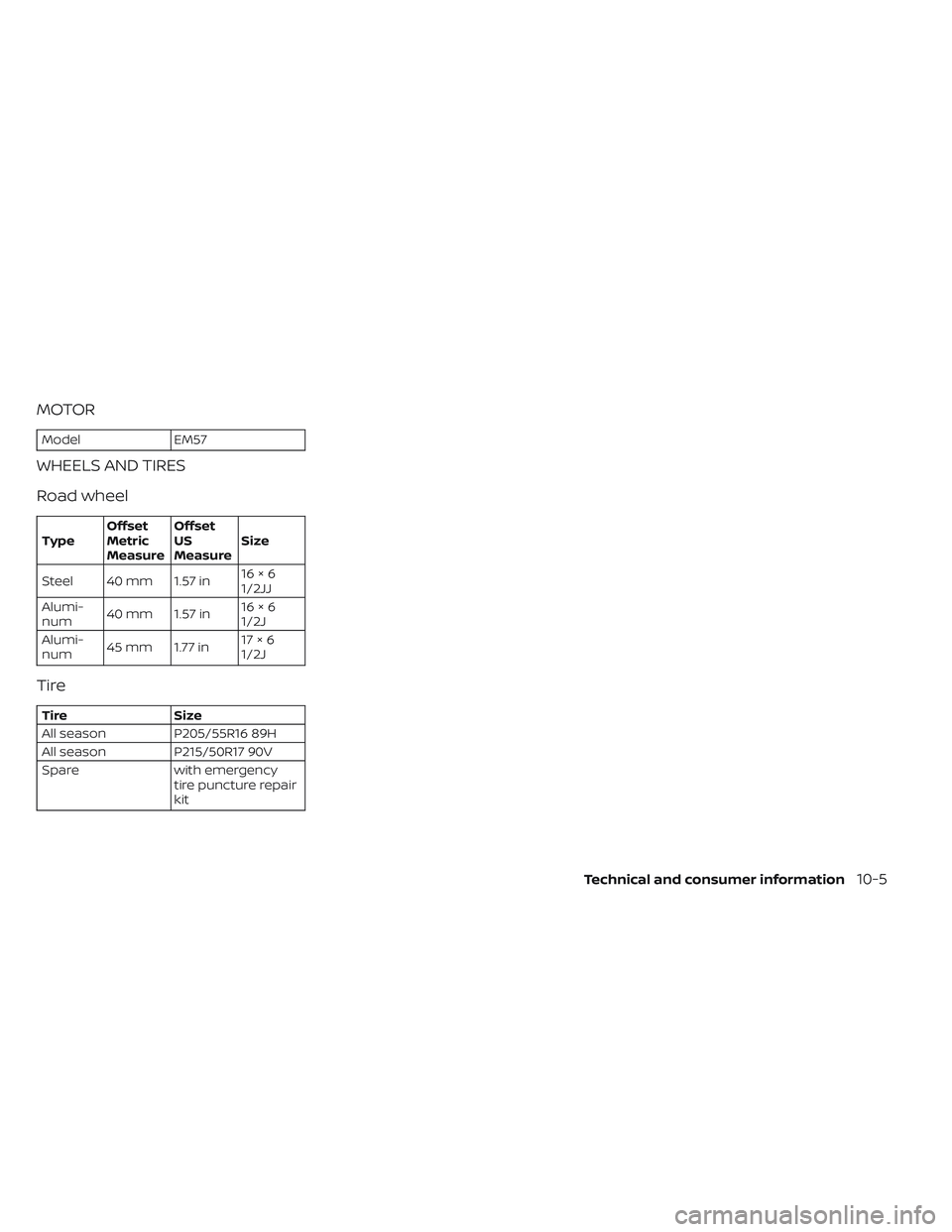
MOTOR
ModelEM57
WHEELS AND TIRES
Road wheel
TypeOffset
Metric
Measure Offset
US
Measure
Size
Steel 40 mm 1.57 in 16×6
1/2JJ
Alumi-
num 40 mm 1.57 in 16×6
1/2J
Alumi-
num 45 mm 1.77 in 17×6
1/2J
Tire
Tire
Size
All season P205/55R16 89H
All season P215/50R17 90V
Spare with emergency
tire puncture repair
kit
Technical and consumer information10-5
Page 583 of 612

DIMENSIONS AND WEIGHTS
Metric
MeasureUS
Measure
Overall length 4,480 mm 176.4 in
Overall length (with license plate) 4,490 mm 176.8 in
Overall width 1,790 mm 70.5 in
Overall width (with outside mirrors) 2,029 mm 79.9 in
Overall height (Roof, 40 kWh Battery Model) 16 inch wheels 1,561 mm 61.5 in
17 inch wheels 1,567 mm 61.7 in
Overall height (Roof, 60 kWh Battery Model) 16 inch wheels 1,550 mm 61.0 in
17 inch wheels 1,555 mm 61.2 in
Overall height (Antenna, 40 kWh Battery Model) 16 inch wheels 1,560 mm 61.4 in
17 inch wheels 1,565 mm 61.6 in
Overall height (Antenna, 60 kWh Battery Model) 16 inch wheels 1,565 mm 61.6 in
17 inch wheels 1,575 mm 62.0 in
Front track 16 inch wheels 1,540 mm 60.6 in
17 inch wheels 1,530 mm 60.2 in
Rear track 16 inch wheels 1,555 mm 61.2 in
17 inch wheels 1,545 mm 60.8 in
Wheelbase 2,700 mm 106.3 in
Gross Vehicle Weight Rating (GVWR) Refer to the F.M.V.S.S. or C.M.V.S.S.
certification label on the driver’s side
center pillar.
Gross Axle Weight Rating (GAWR)
Front
Rear
10-6Technical and consumer information
Page 584 of 612
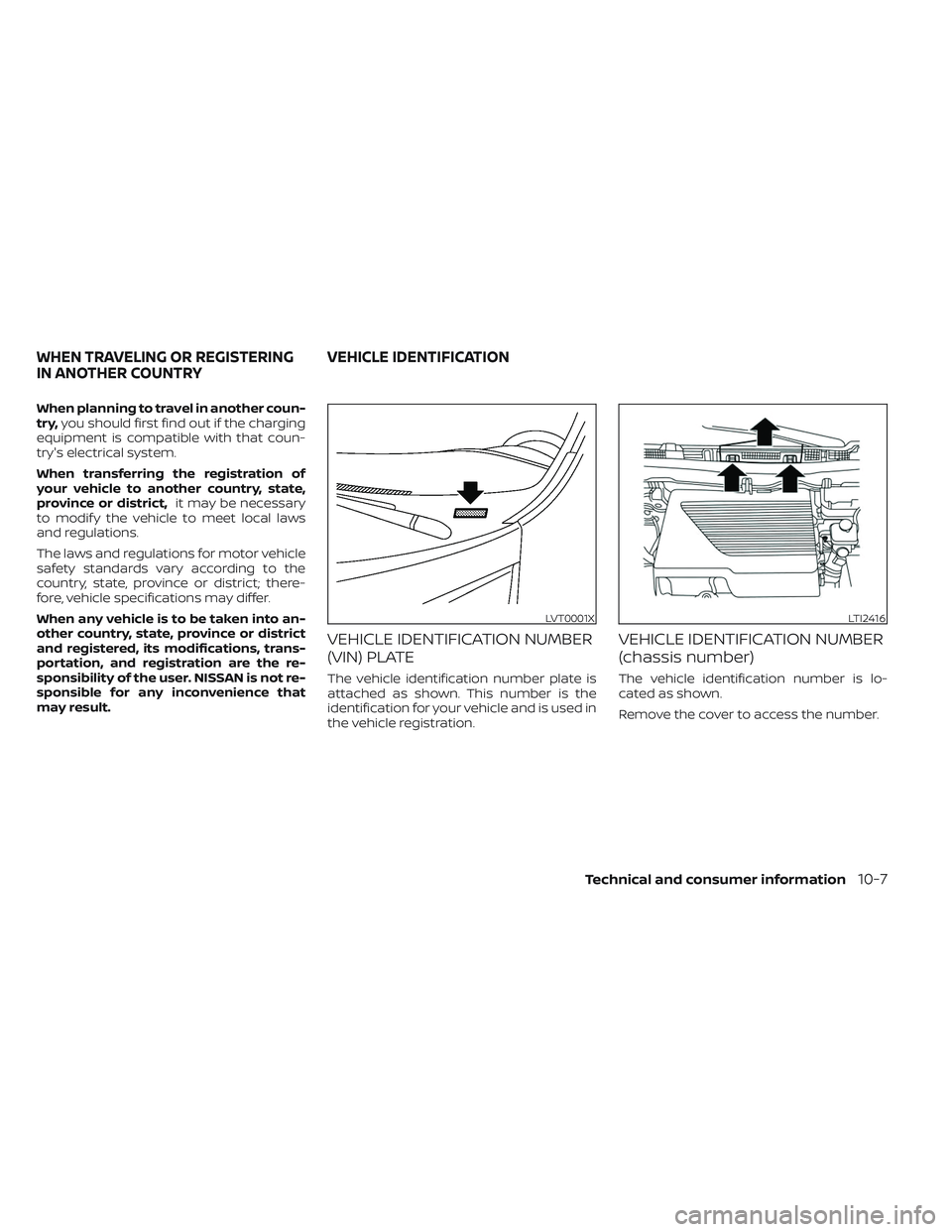
When planning to travel in another coun-
try,you should first find out if the charging
equipment is compatible with that coun-
try's electrical system.
When transferring the registration of
your vehicle to another country, state,
province or district, it may be necessary
to modif y the vehicle to meet local laws
and regulations.
The laws and regulations for motor vehicle
safety standards vary according to the
country, state, province or district; there-
fore, vehicle specifications may differ.
When any vehicle is to be taken into an-
other country, state, province or district
and registered, its modifications, trans-
portation, and registration are the re-
sponsibility of the user. NISSAN is not re-
sponsible for any inconvenience that
may result.
VEHICLE IDENTIFICATION NUMBER
(VIN) PLATE
The vehicle identification number plate is
attached as shown. This number is the
identification for your vehicle and is used in
the vehicle registration.
VEHICLE IDENTIFICATION NUMBER
(chassis number)
The vehicle identification number is lo-
cated as shown.
Remove the cover to access the number.
LVT0001XLTI2416
WHEN TRAVELING OR REGISTERING
IN ANOTHER COUNTRY VEHICLE IDENTIFICATION
Technical and consumer information10-7
Page 585 of 612
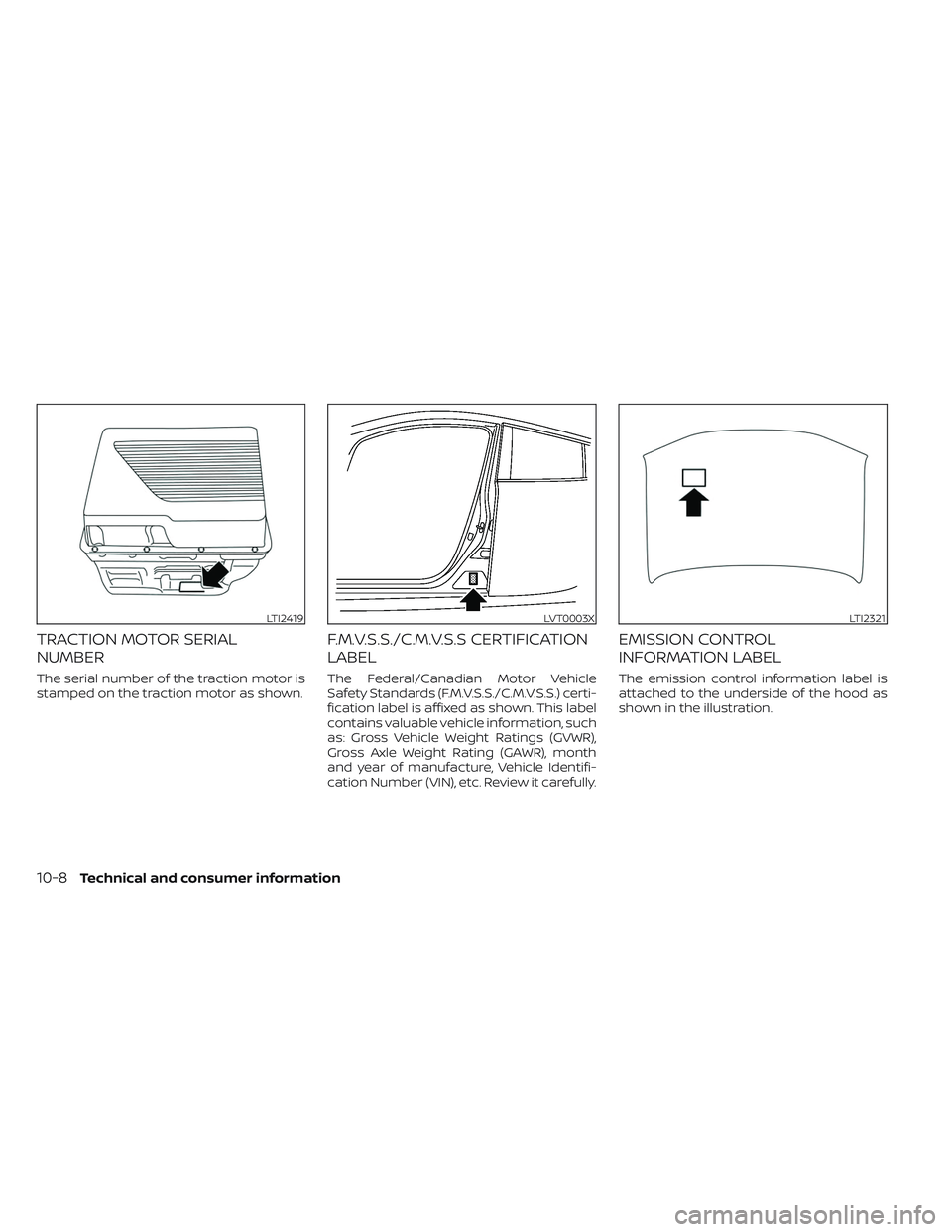
TRACTION MOTOR SERIAL
NUMBER
The serial number of the traction motor is
stamped on the traction motor as shown.
F.M.V.S.S./C.M.V.S.S CERTIFICATION
LABEL
The Federal/Canadian Motor Vehicle
Safety Standards (F.M.V.S.S./C.M.V.S.S.) certi-
fication label is affixed as shown. This label
contains valuable vehicle information, such
as: Gross Vehicle Weight Ratings (GVWR),
Gross Axle Weight Rating (GAWR), month
and year of manufacture, Vehicle Identifi-
cation Number (VIN), etc. Review it carefully.
EMISSION CONTROL
INFORMATION LABEL
The emission control information label is
attached to the underside of the hood as
shown in the illustration.
LTI2419LVT0003XLTI2321
10-8Technical and consumer information
Page 586 of 612
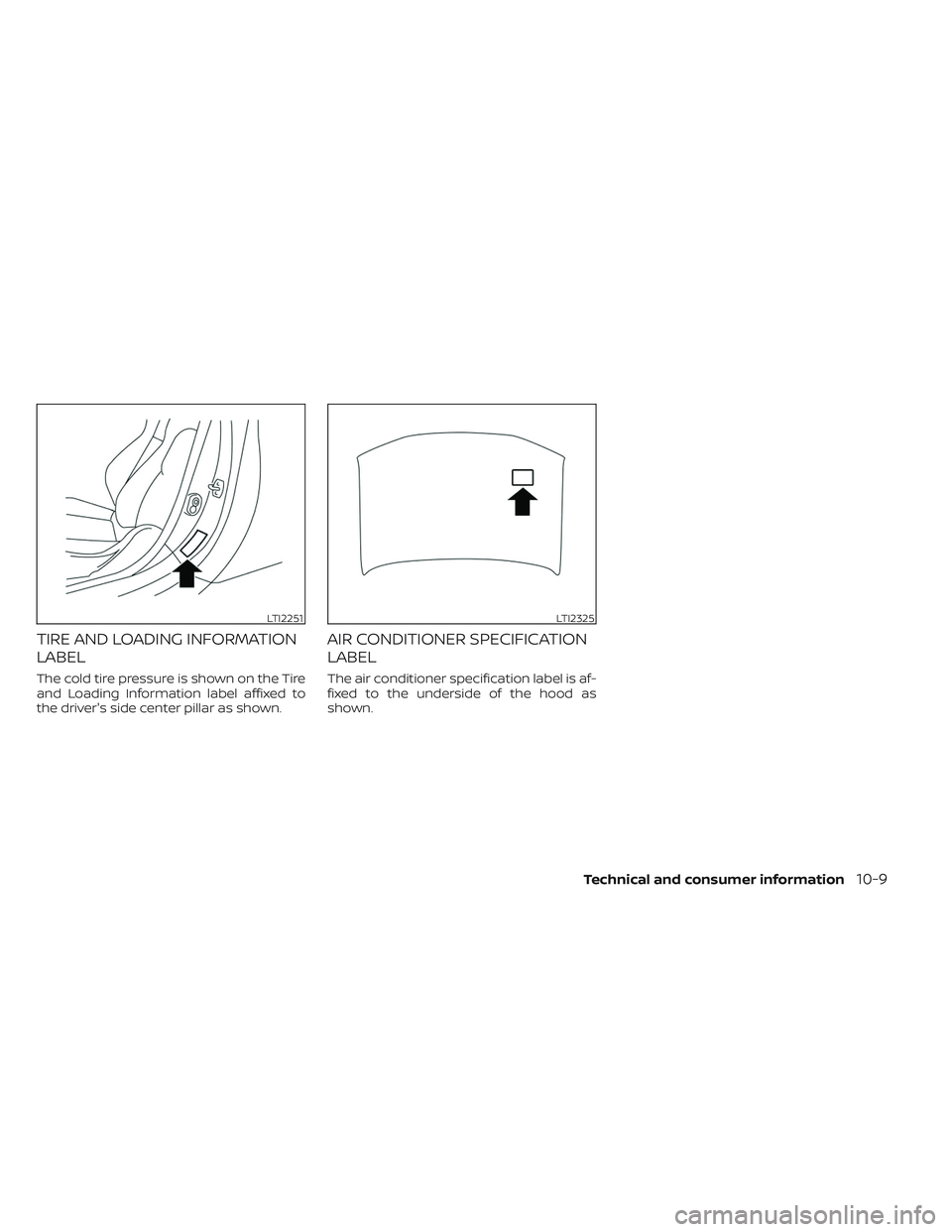
TIRE AND LOADING INFORMATION
LABEL
The cold tire pressure is shown on the Tire
and Loading Information label affixed to
the driver's side center pillar as shown.
AIR CONDITIONER SPECIFICATION
LABEL
The air conditioner specification label is af-
fixed to the underside of the hood as
shown.
LTI2251LTI2325
Technical and consumer information10-9
Page 587 of 612
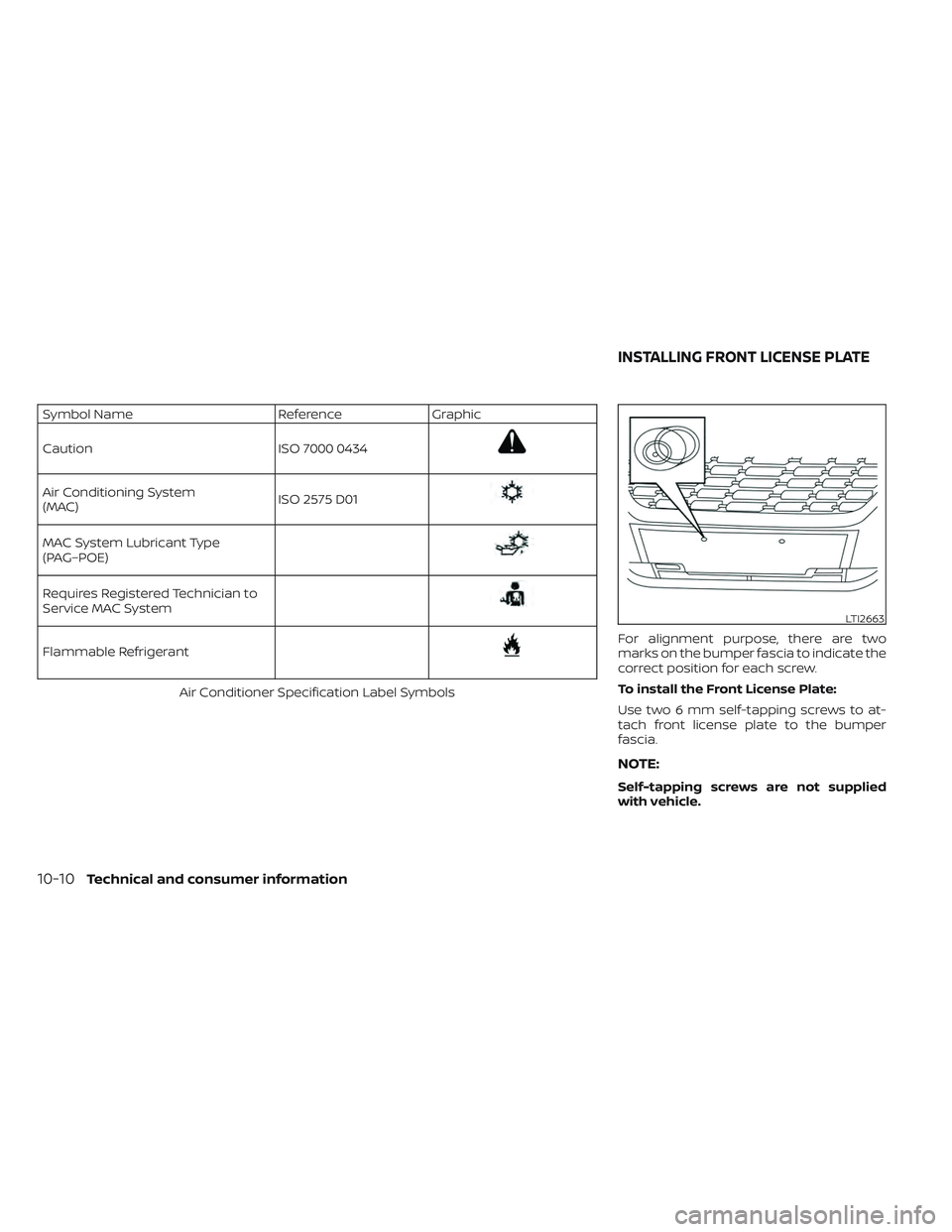
Symbol NameReferenceGraphic
Caution ISO 7000 0434
Air Conditioning System
(MAC)ISO 2575 D01
MAC System Lubricant Type
(PAG–POE)
Requires Registered Technician to
Service MAC System
Flammable Refrigerant
Air Conditioner Specification Label Symbols For alignment purpose, there are two
marks on the bumper fascia to indicate the
correct position for each screw.
To install the Front License Plate:
Use two 6 mm self-tapping screws to at-
tach front license plate to the bumper
fascia.
NOTE:
Self-tapping screws are not supplied
with vehicle.
LTI2663
INSTALLING FRONT LICENSE PLATE
10-10Technical and consumer information
Page 588 of 612
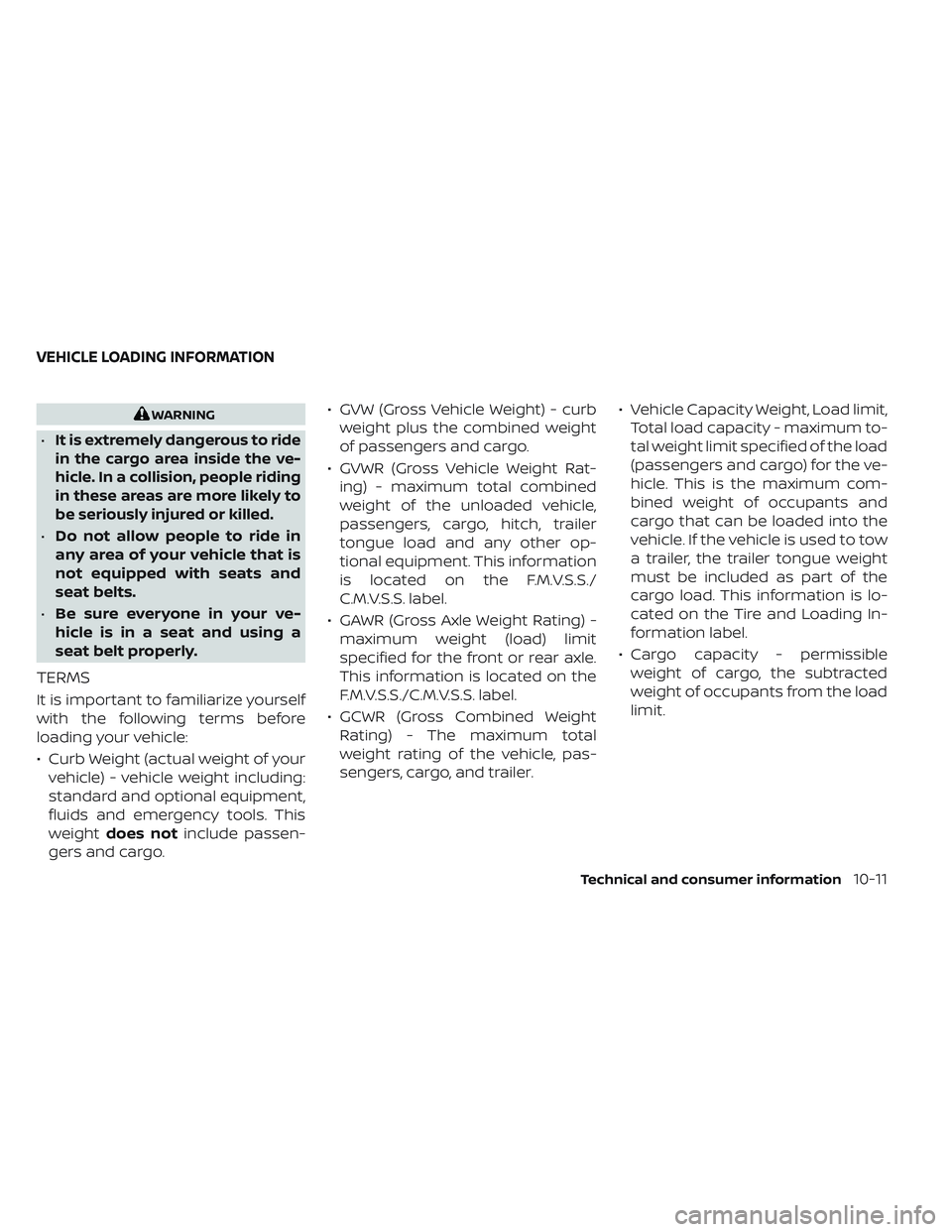
WARNING
•
It is extremely dangerous to ride
in the cargo area inside the ve-
hicle. In a collision, people riding
in these areas are more likely to
be seriously injured or killed.
•Do not allow people to ride in
any area of your vehicle that is
not equipped with seats and
seat belts.
•Be sure everyone in your ve-
hicle is in a seat and using a
seat belt properly.
TERMS
It is important to familiarize yourself
with the following terms before
loading your vehicle:
• Curb Weight (actual weight of your vehicle) - vehicle weight including:
standard and optional equipment,
fluids and emergency tools. This
weight does not include passen-
gers and cargo. • GVW (Gross Vehicle Weight) - curb
weight plus the combined weight
of passengers and cargo.
• GVWR (Gross Vehicle Weight Rat- ing) - maximum total combined
weight of the unloaded vehicle,
passengers, cargo, hitch, trailer
tongue load and any other op-
tional equipment. This information
is located on the F.M.V.S.S./
C.M.V.S.S. label.
• GAWR (Gross Axle Weight Rating) - maximum weight (load) limit
specified for the front or rear axle.
This information is located on the
F.M.V.S.S./C.M.V.S.S. label.
• GCWR (Gross Combined Weight Rating) - The maximum total
weight rating of the vehicle, pas-
sengers, cargo, and trailer. • Vehicle Capacity Weight, Load limit,
Total load capacity - maximum to-
tal weight limit specified of the load
(passengers and cargo) for the ve-
hicle. This is the maximum com-
bined weight of occupants and
cargo that can be loaded into the
vehicle. If the vehicle is used to tow
a trailer, the trailer tongue weight
must be included as part of the
cargo load. This information is lo-
cated on the Tire and Loading In-
formation label.
• Cargo capacity - permissible weight of cargo, the subtracted
weight of occupants from the load
limit.
VEHICLE LOADING INFORMATION
Technical and consumer information10-11
Page 589 of 612
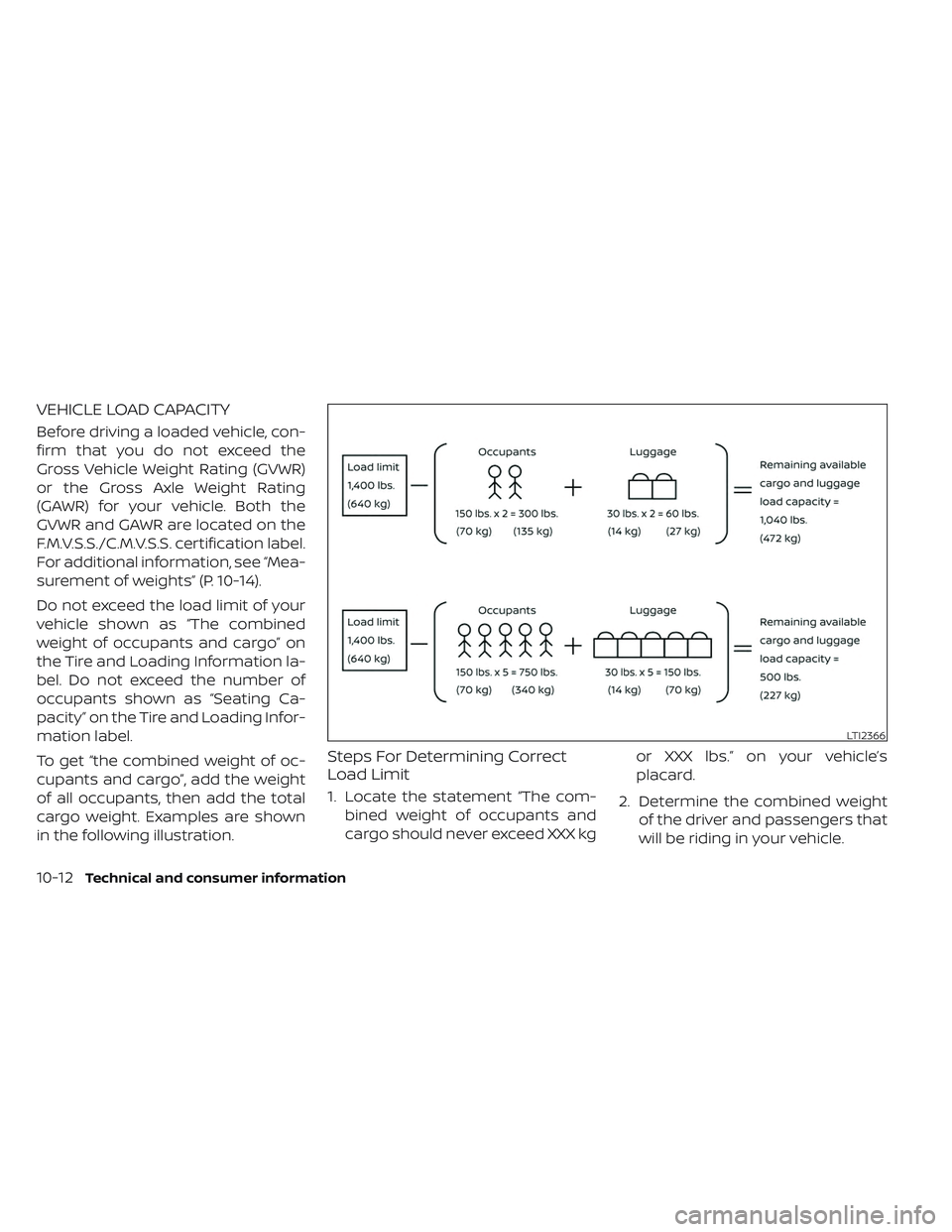
VEHICLE LOAD CAPACITY
Before driving a loaded vehicle, con-
firm that you do not exceed the
Gross Vehicle Weight Rating (GVWR)
or the Gross Axle Weight Rating
(GAWR) for your vehicle. Both the
GVWR and GAWR are located on the
F.M.V.S.S./C.M.V.S.S. certification label.
For additional information, see “Mea-
surement of weights” (P. 10-14).
Do not exceed the load limit of your
vehicle shown as “The combined
weight of occupants and cargo” on
the Tire and Loading Information la-
bel. Do not exceed the number of
occupants shown as “Seating Ca-
pacity” on the Tire and Loading Infor-
mation label.
To get “the combined weight of oc-
cupants and cargo”, add the weight
of all occupants, then add the total
cargo weight. Examples are shown
in the following illustration.
Steps For Determining Correct
Load Limit
1. Locate the statement “The com-bined weight of occupants and
cargo should never exceed XXX kg or XXX lbs.” on your vehicle’s
placard.
2. Determine the combined weight of the driver and passengers that
will be riding in your vehicle.
LTI2366
10-12Technical and consumer information
Page 590 of 612
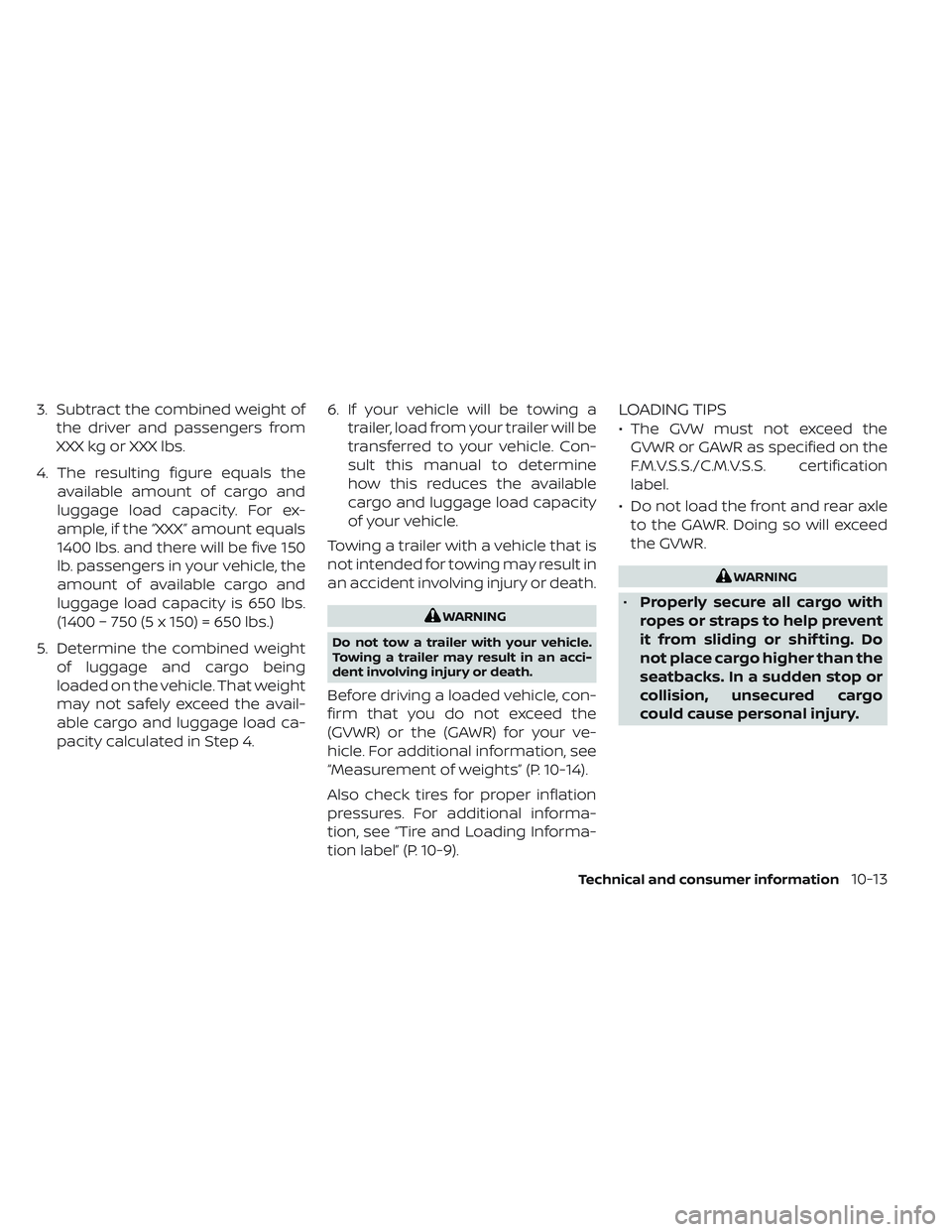
3. Subtract the combined weight ofthe driver and passengers from
XXX kg or XXX lbs.
4. The resulting figure equals the available amount of cargo and
luggage load capacity. For ex-
ample, if the “XXX ” amount equals
1400 lbs. and there will be five 150
lb. passengers in your vehicle, the
amount of available cargo and
luggage load capacity is 650 lbs.
(1400 − 750 (5 x 150) = 650 lbs.)
5. Determine the combined weight of luggage and cargo being
loaded on the vehicle. That weight
may not safely exceed the avail-
able cargo and luggage load ca-
pacity calculated in Step 4. 6. If your vehicle will be towing a
trailer, load from your trailer will be
transferred to your vehicle. Con-
sult this manual to determine
how this reduces the available
cargo and luggage load capacity
of your vehicle.
Towing a trailer with a vehicle that is
not intended for towing may result in
an accident involving injury or death.
WARNING
Do not tow a trailer with your vehicle.
Towing a trailer may result in an acci-
dent involving injury or death.
Before driving a loaded vehicle, con-
firm that you do not exceed the
(GVWR) or the (GAWR) for your ve-
hicle. For additional information, see
“Measurement of weights” (P. 10-14).
Also check tires for proper inflation
pressures. For additional informa-
tion, see “Tire and Loading Informa-
tion label” (P. 10-9).
LOADING TIPS
• The GVW must not exceed the GVWR or GAWR as specified on the
F.M.V.S.S./C.M.V.S.S. certification
label.
• Do not load the front and rear axle to the GAWR. Doing so will exceed
the GVWR.
WARNING
• Properly secure all cargo with
ropes or straps to help prevent
it from sliding or shif ting. Do
not place cargo higher than the
seatbacks. In a sudden stop or
collision, unsecured cargo
could cause personal injury.
Technical and consumer information10-13